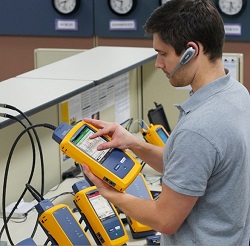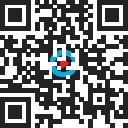Cabling Chronicles
Look, No Hands!
Did you ever have one of those days where your hands feel like two foreign objects that aren’t connected to your body or your brain? Yesterday started off as one of those days for me. It went something (maybe not exactly) like this.
The first mistake was my decision to carry too much stuff out to my truck while simultaneously balancing my coffee. It didn’t go very well. Not only was I now five minutes late from running back in to change my shirt, but now I had a cleaning charge to worry about.
May 30, 2018
Keeping Up has Never Been Easier!
Keeping up with the industry is not easy. Changing standards, ways of working, technologies … Don’t worry – we have your back! We know it is sometimes hard to find the exact information you need to keep you moving forward here are some resources that will help you keep up and move ahead.
May 23, 2018
How Many Stars are in Your Toolbelt?
We talk a lot about certifying copper cable plants using Fluke Networks’ DSX CableAnalyzer series certifiers, but voice, video and data deployments start with technicians having the right copper installation tools.
While Fluke Networks offers a wide range of copper and fiber installation tools designed to streamline the job and make you more productive, we thought it would be fun to take a look at our top 5 everyday copper installation tools from an Amazon.com point of view.
May 16, 2018
Picture Perfect AV Systems
Whether it’s video conferencing or digital signage, many of you are likely facing requests from your customers to deploy cable plants that support audio-visual systems.
May 9, 2018
Upgrading to Four-Pair PoE: What You Need to Know
For several years, you’ve been deploying cable plants that support power over Ethernet (PoE) for variety of devices like VoIP phones and security cameras. So far, up to 30 Watts is all you’ve been requested to support, but with the plethora of devices now able to take advantage of higher levels of PoE—like the latest 802.11ac Wi-Fi access points, digital displays and even desktop computers—your customers are starting to ask for four-pair PoE.
May 2, 2018
Why can’t I use the 2-cord test method?
Like the TIA and ISO, Fluke Networks promotes the use of the 1-cord method to set reference for fiber loss measurements. The 1-cord method is where a launch cord is attached to a light source and the other end to a power meter. A reference is then set (the power measured is defined as 0 dB). Next, the launch cord is disconnected from the power meter, but not the light source. Then the far end of the launch cord is attached to the cabling under test and a receive cord between the far end of the cabling under test and the power meter.
April 25, 2018
Cable Testing 101: But the Standard Says 0.75 dB!
We’ve covered fiber insertion loss testing in depth in many blogs, so by now you should know that it is the loss of signal that happens in a channel due to the length of the cable and any connectors, splices or splitters.
And hopefully you also know that estimating your loss budget involves adding up the loss of all of these components to make sure you’re within the loss limits specified by IEEE standards for the application you plan to run.
April 18, 2018
Let’s All Calibrate and Have a Good Time!
Just like those who drive around long after the engine service indicator lights up on the dashboard, there are folks out there who have likely been putting off getting their t

ester calibrated despite the email or LinkWare™ Live notification from Fluke Networks.
April 4, 2018
Too Soon to Say Goodbye? It’s All Relative…
You might remember that just about three years ago, the DTX CableAnalyzer™ was officially retired. Since its discontinuation, Fluke Networks has continued to offer technical support, repair and calibration for this tester that was once touted as the ultimate time saver and brought testing to a whole new level when it was introduced in 2004.
March 28, 2018
101 Series: LEDs vs. VCSELs
Since today’s high-speed fiber networks use 850-nm vertical-cavity surface-emitting laser (VCSELs) transceivers, some may be confused about why light emitting diode (LED) light sources are used for testing. Understanding the differences between these two sources will certainly shed some light.
March 21, 2018




